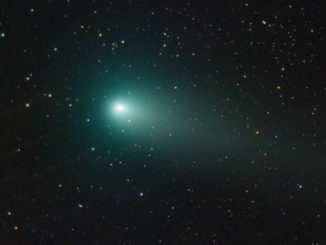
Auriga


Catch close Comet 46P/Wirtanen near the Pleiades on 16 December
Bright Comet 46P/Wirtanen skims past Earth just 30 lunar distances away on 16 December when it could become a diffuse magnitude +3 object almost a degree wide located between the Pleiades and Aldebaran in the constellation of Taurus. Grab your binoculars and find a dark sky location well away from streetlights to enjoy this Christmas comet before the glow from a waxing Moon gets too bright from 17 December.

See bright Comet 21P’s close brush with conspicuous Capella
If you’ve never seen a comet, there’s currently a bright example visible in the late evening about to make a close approach to the 6th brightest star in the night sky on the UK night of 2–3 September. We show you how to find Comet 21P/Giacobini-Zinner around the time it passes within a degree of prominent star Capella.

See asteroid Phaethon, source of the Geminids, in a close brush with Earth
As shooting-star devotees prepare for the naked-eye spectacle of the Geminid meteor shower in mid-December, owners of small telescopes can also witness the close passage of the meteors’ parent body — a curious “rock comet” known as 3200 Phaethon, galloping through the constellations of Auriga, Perseus, Andromeda, Pisces and Pegasus at a rate of up to 15 degrees/day.

Halloween near-Earth asteroid 2003 YT1 has Polaris encounter on 2 November
At 9:24am GMT on 31 October 2016, near-Earth asteroid 164121 (2003 YT1) will safely fly by at a distance of 3.2 million miles (5.2 million kilometres), or 13.5 times the distance of the Moon. Furthermore, this 1.1-mile-(1.7-kilometre)-wide Apollo asteroid also passes very close to Polaris early on 2 November, creating a rare astrophotographic and observing opportunity.

Discovering the X-ray treasures in Chandra’s archives
Each year, NASA’s Chandra X-ray Observatory helps celebrate American Archive Month by releasing a collection of images using X-ray data. Each of these six new images — representing just a small fraction of the treasures that reside in Chandra’s unique archive — also includes data from telescopes covering other parts of the electromagnetic spectrum, such as visible and infrared light.

Spitzer sees a space spider watching over young stars
The “Spider Nebula” glows fluorescent green in an infrared image from NASA’s Spitzer Space Telescope and the Two Micron All Sky Survey (2MASS). Nebulae are clouds of interstellar gas and dust where stars can form. The Spider, officially named IC 417, is located about 10,000 light-years from Earth in the constellation Auriga.

Disco lights from a galaxy cluster seen with multi-spectral eyes
MACS J0717, some 5.4 billion light-years away from Earth in the constellation of Auriga (The Charioteer), is the result of four galaxy clusters colliding. This image is a combination of observations in visible light, X-rays and radio waves from the NASA/ESA Hubble Space Telescope, NASA’s Chandra X-ray Observatory, and the NRAO Jansky Very Large Array.
